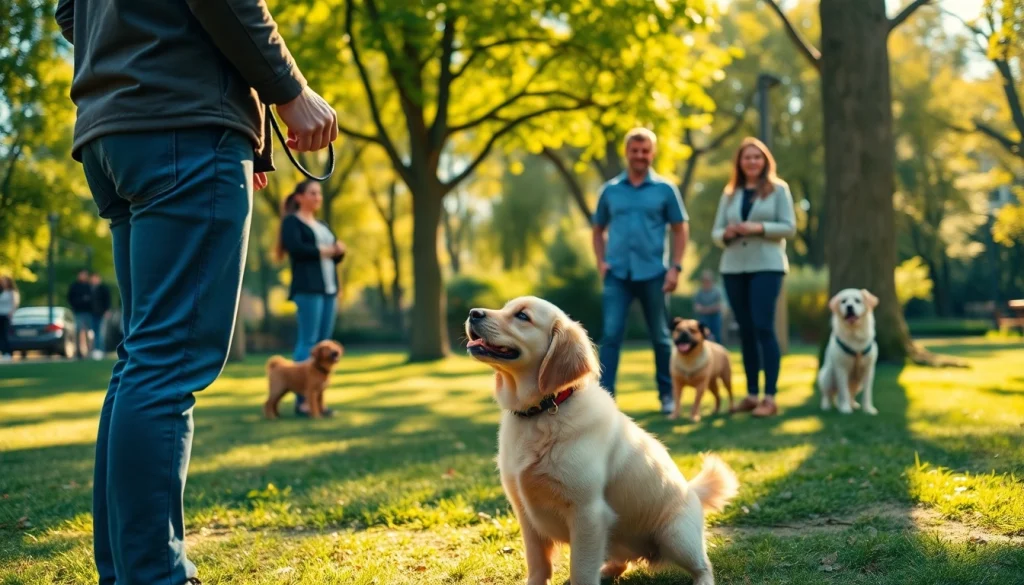Understanding the Basics of Dog Training in Irvine
Dog training is not merely a luxury for pet owners; it is an essential aspect of pet ownership and responsible guardianship. In Irvine, California, a city known for its vibrant community and picturesque parks, proper dog training plays a vital role in ensuring that both pets and their owners enjoy a harmonious relationship. Training helps in developing a dog’s obedience, social skills, and behaviors that are crucial for their integration into daily life. When looking for high-quality training, it’s beneficial to explore options such as Dog Training Irvine to ensure effective results.
What Makes Dog Training Essential for Pet Owners?
Effective dog training leads to healthier, happier pets and provides numerous benefits for both the animal and the owner. Here are a few key reasons why dog training is indispensable:
- Improved Behavior: A well-trained dog is less likely to engage in destructive behaviors, which can range from excessive barking to chewing up furniture.
- Enhanced Communication: Training establishes a clear line of communication between the owner and the dog, making it easier to manage the dog’s behaviors.
- Socialization: Training provides opportunities for social interaction with other dogs and people, reducing anxiety and aggression in unfamiliar situations.
- Safety: A trained dog is typically more responsive in emergency situations, which is crucial for the safety of both the dog and the owner.
- Strengthened Bond: Training sessions can strengthen the emotional connection between dogs and their owners, fostering mutual respect and understanding.
Key Principles of Effective Dog Training
Successful dog training is built on foundational principles that every trainer and pet owner should understand:
- Consistency: Consistency in commands, rewards, and expectations is crucial. Every family member should be on the same page to avoid confusing the dog.
- Positive Reinforcement: This method involves rewarding desired behaviors rather than punishing undesired ones, creating a positive learning environment.
- Patience: Dogs learn at their own pace. Trainers must remain patient and avoid frustration to cultivate a supportive environment for learning.
- Proper Timing: The timing of rewards is essential; they should be given immediately after the desired behavior occurs to encourage repetition.
- Realistic Expectations: Understanding a dog’s individual temperament and breed characteristics can help set realistic training goals.
Common Dog Behavior Challenges Faced by Owners
Even with the best training techniques, dog owners may encounter various behavioral challenges. Identification and understanding of these issues can aid in implementing corrective measures. Some common challenges include:
- Excessive Barking: Dogs may bark due to boredom, fear, or to get attention. Training should focus on the triggers of barking.
- Leash Pulling: Many dogs pull on their leashes during walks, leading to frustration. This can often be addressed through training techniques such as “loose leash walking.”
- Separation Anxiety: Dogs that exhibit clinginess or destructive behaviors when left alone often suffer from separation anxiety.
- Jumping on People: This common behavior can be mitigated through training that teaches dogs to greet guests calmly.
- Aggression: Any aggression displayed by a dog towards people or other pets should be addressed immediately with the help of a professional trainer.
Finding the Right Dog Training Class in Irvine
With so many options available for dog training in Irvine, it is vital to find a program that suits your dog’s needs and your personal training goals. Here are key guidelines to help you in your search:
Evaluating Training Programs: What to Look For
Choosing the right dog training program can be overwhelming. Owners should look for the following aspects when evaluating training programs:
- Trainer Credentials: Look for trainers with certifications from recognized organizations, experience, and positive training philosophy.
- Training Methods: Ensure that the training methods used are humane and rooted in positive reinforcement.
- Program Structure: Check whether the program offers a structure that fits your schedule, needs, and the specific goals you have for your pet.
- Facility Environment: Visit the training facility to assess cleanliness, safety, and overall atmosphere. Is it a welcoming space for dogs and their owners?
- Class Size: Smaller classes often lead to more individual attention, enhancing the overall training experience.
Benefits of Group Classes vs. Private Lessons
The choice between group classes and private lessons requires careful consideration of both dog and owner preferences:
- Group Classes:
- Encourage socialization with other dogs.
- Offer a supportive environment with peer interaction.
- May be more cost-effective than private sessions.
- Private Lessons:
- Provide customized training towards specific issues.
- Allow for more focused learning tailored to a dog’s unique personality.
- Fit better into busy schedules, allowing flexibility in training times.
Top Recommendations for Dog Trainers in Irvine
There are several reputable dog training programs in Irvine. Here are a few standout options:
- Manners for Mutts: This program focuses on positive reinforcement training methods and specializes in family dog training.
- Paw Sweet Paw: They provide personalized training options, including private sessions and various packages that cater to different needs.
- Wags & Wiggles: Offers group classes and private lessons, with a focus on socialization and longevity in training techniques.
- Good Dog OC: Specializes in advanced obedience training and behavior modification programs.
- OC Canine Coaching: Known for tailored solutions addressing anxiety, aggression, and specific behavioral issues.
Popular Dog Training Techniques and Methods
Understanding various dog training techniques can empower owners to choose the best methods for their furry friends. Here are some commonly practiced techniques:
The Power of Positive Reinforcement in Dog Training Irvine
Positive reinforcement is widely recognized as one of the most effective and humane methods of dog training:
- Concept Understanding: This method involves rewarding good behavior with treats, praise, or toys when the dog performs desired actions.
- Building Trust: Positive reinforcement fosters a trusting relationship and encourages dogs to behave well out of eagerness to please their owner.
- Establishing Desired Behavior: By repeatedly rewarding good behavior, dogs are likely to repeat such actions, creating a pattern of positive behavior.
Understanding Clicker Training and Its Benefits
Clicker training is a popular method within the realm of positive reinforcement:
- Mechanism: The trainer uses a small clicker device that makes a distinct sound to mark the exact moment a desired behavior occurs.
- Precision: The clarity of the click allows dogs to understand precisely what behavior is being rewarded, streamlining the training process.
- Encouraging Communication: It enhances communication between the owner and the dog, making each training session more effective.
Utilizing Obedience Training for Better Behavior
Obedience training provides foundational commands that shape a dog’s behavior:
- Basic Commands: Teaching commands like “sit,” “stay,” “come,” and “down” equips dogs with essential skills for everyday life.
- Real-Life Application: Behavioral commands can help in real-world situations, such as preventing a dog from running into the street or jumping on guests.
- Thoughtful Adaptation: Owners should adapt their training techniques according to their dog’s learning style and temperament, ensuring training remains effective and enjoyable.
Specialized Dog Training Services in Irvine
In addition to basic obedience training, specialized programs exist to address specific needs of dogs. These programs cater to various aspects of dog behavior and training:
Puppy Training: The Foundation for Lifelong Learning
Puppy training is critical for ensuring a well-adjusted adult dog:
- Socialization: Early exposure to different environments, people, and pets helps mitigate fear and anxiety later in life.
- Foundation Skills: Basic commands introduced during puppy training lay the groundwork for more advanced training in the future.
- Building Good Habits: Establishing routines during puppyhood can significantly reduce problematic behaviors as dogs mature.
Behavioral Modifications for Aggressive Dogs
Addressing aggression in dogs is paramount for the safety of both the pet and its surroundings:
- Identifying Triggers: Understanding what provokes aggressive behaviors is essential for creating an effective training plan.
- Gradual Desensitization: Behavioral training often involves gradual exposure to the triggers of aggression in a controlled way.
- Professional Guidance: Seeking help from certified trainers or behaviorists is crucial in developing a robust plan for modifying aggressive behavior without further escalating the issue.
Advanced Training: Preparing for Therapy and Service Roles
Advanced training can enable dogs to serve in critical support roles, such as therapy and service animals:
- Preparing for Service Work: This involves specialized tasks like guiding individuals who are visually impaired, alerting to medical conditions, or providing emotional support.
- Certification Requirements: Many organizations require specific training and testing for dogs in therapy and service roles, ensuring that they can perform effectively in varied settings.
- Monitoring and Continual Training: Ongoing training and assessment ensure that the dogs maintain their skills and adapt to their owner’s needs over time.
Measuring Success in Dog Training
Tracking progress in dog training can be exciting yet challenging. Here are ways to measure success and adjust training techniques accordingly:
How to Monitor Your Dog’s Progress
Monitoring your dog’s development is integral to effective training:
- Behavioral Logs: Keeping detailed notes on behaviors during training sessions can provide insights into what techniques are working or what needs adjustment.
- Regular Assessments: Frequent evaluations of your dog’s skills through practical tests can highlight progress and areas needing further work.
- Feedback from Trainers: Engaging with trainers for additional insights can be invaluable in shaping future training strategies.
Adjusting Techniques Based on Training Outcomes
Flexibility in training methods can vastly improve outcomes:
- Responsive Adaptation: If certain methods are not yielding the desired results, be prepared to pivot to new techniques.
- Incorporate Variety: Varying rewards and techniques can keep training fresh and engaging for the dog.
- Identify Learning Styles: Understanding whether your dog is a visual learner, auditory learner, or kinesthetic learner can tailor methods that enhance learning.
Long-term Benefits of Consistent Dog Training Practices
The benefits of consistent dog training extend far beyond mere obedience:
- Enduring Command Mastery: Dogs trained using established techniques are likely to retain learned commands and behaviors throughout their lives.
- Improved Quality of Life: Well-behaved dogs often enjoy richer, more fulfilling lives due to their ability to navigate various social situations smoothly.
- Owner Satisfaction: The joy and pride derived from owning a well-trained pet contributes significantly to an owner’s satisfaction.





